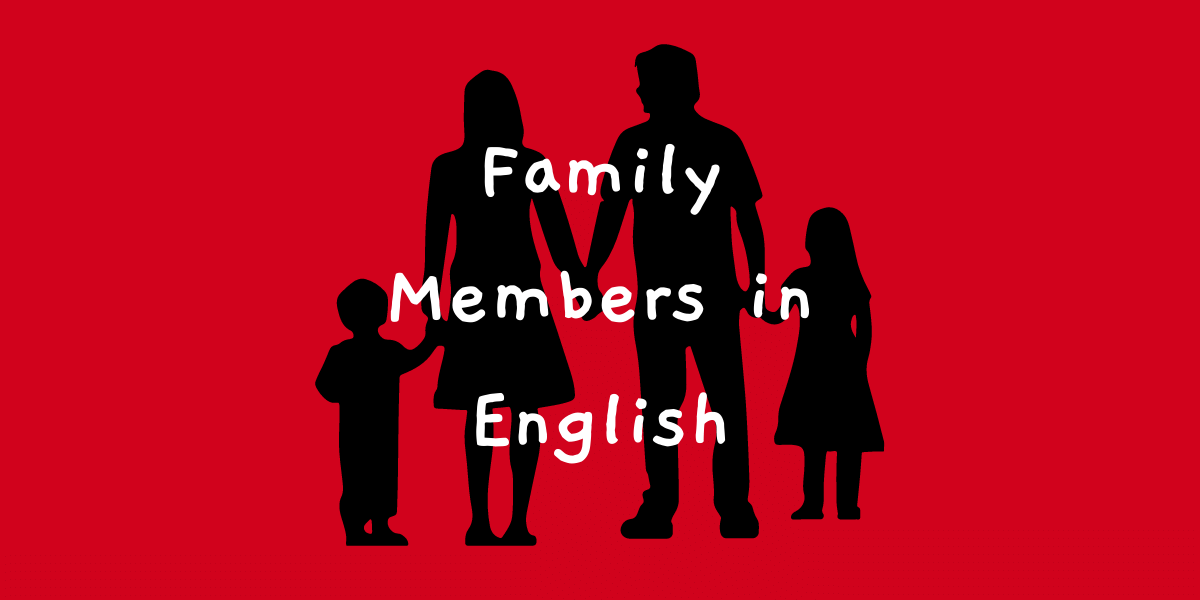Family Members in English
Family Members in English
There is nothing more important in this world than family. For the first five years of your child’s life, people in your family are probably the only people that they know. For this reason, we often like to teach family members in English as one of our first lessons.
Family members can be a bit difficult in different languages, and English is no different. To make it easy, we have made some charts to identify the names we call people based on where they are in our family tree. Remember that these names can change based on your relationship with that person. Dad to you might be a brother to someone else.
Some family members names may be too hard or unimportant for young children, so don’t worry about teaching them all of this. We have tried to make our diagrams as easy as possible to understand, but if you still have questions, you can ask us by clicking on the image below.

Family Member List
We have broken our family member lists into five parts: immediate family, extended family, in-laws, and stepfamily. Most likely, young children will only need to know the first two lists. More advanced learners may want to learn the rest.
Immediate Family: Family Member List
Your immediate family is typically those people who live with you: your parents and siblings. A sibling is another name for a brother or sister. Typically we do not consider grandparents to be part of the immediate family.

Members of the Family for Kids
Mom
Dad
(older/younger)Brother
(older/younger) Sister
Members of the Family for Parents
Wife (a female spouse)
Husband (a male spouse)
Son
Daughter
Extended Family: Family Member List
Your extended family includes your immediate family, but it also includes your aunts, uncles, cousins, and grandparents.

Extended Family for Children
Grandma (Grandmother) (the mom of your parent)
Grandpa (Grandfather) (the dad of your parent)
Uncle (the brother of your parent)
Aunt (the sister of your parent)
(older/younger) Cousin (the son or daughter of your aunts or uncles)
Extended Family for Parents
Niece (the daughter of your brother or sister)
Nephew (the son of your brother or sister)
Extended Family for Grandparents
Grandchildren (the children of your children)
Grandson (the son of your child)
Granddaughter (the daughter of your child)
What is a Stepfamily?
Not everyone has a stepfamily. Stepfamilies happen when parents get divorced and then re-marry. The new spouses (and their families) are considered your stepfamily. When referring to these people, we just add “step” before the normal titles we would normally use.

Stepmom (your parent’s new wife)
Stepdad (your parent’s new husband)
Stepbrother (your step-mom or step-dad’s son)
Stepsister (your step-mom or step-dad’s daughter)
Stepaunt (your step-parent’s sister)
Stepuncle (your step-parent’s brother)
Stepcousin (your step-aunt or step-uncle’s child)
I have never heard of anyone referring to any family as “step” beyond this group of people, but you could conceivably have a step-grandfather or step-grandmother as well.
What is an In-Law?
An in-law is someone who is in your family due to marriage. These people technically are not blood-related to you, but would still be considered family. One note, we do not say aunt-in-law or uncle-in-law, for the aunts or uncles you have that are not blood-related to you. They are still just referred to as aunts or uncles.

Mother-in-law (your spouse’s mom)
Father-in-law (your spouse’s dad)
Sister-in-law (your spouse’s sister or your sibling’s wife)
Brother-in-law (your spouse’s brother or your sibling’s husband)
Men in the Family
Brother
Son
Father
Husband
Grandpa
Uncle
Cousin (male)
Women in the family
Daughter
Sister
Mother
Wife
Grandma
Aunt
Cousin (female)
Family Flashcards
To help you teach your child basic English, we have made you a set of family flashcards to practice with. To get some ideas of how you can use these cards, take a look at our post on vocabulary games.
We have kept our flashcards to the basic extended family. If you want to drill additional members like step aunts or sisters-in-law you will need to make these yourself. However, for most children, these words shouldn’t be needed.
Family Members in English Teaching Strategy
If you are teaching a young child, I would start with the immediate family. From there, you can expand to aunts, uncles, grandparents, and cousins. Past this, I’m not sure children need to learn much more about family members’ names in English.
If your family has a stepfamily, then it may be a good idea to teach this vocabulary as well. The important thing here is relevance. If a stepfamily is relevant to your child, then you should teach it.
To learn more about structuring lessons, take a look at our post on making good vocabulary lessons in 6 easy steps.
Final Thoughts
When we first begin teaching children English, we want to give them the tools to talk about what is important in their life. What could be more important than the family they see every day? For that reason, we have made these resources to help you introduce family vocabulary to your child.
We hope these flashcards and diagrams have been helpful to you. If they have, we would love to hear from you. If they are confusing in any way, please tell us so we can try to make them better.

